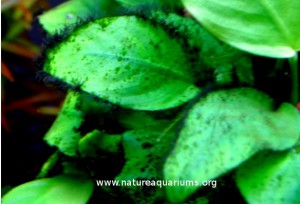Algae are a plant like organisms that requires 3 things; light, water and nutrients. It is for a fact that algae exist in every single aquarium. It is a sign of a healthy and aquarium. However, in excessive amount, this tends to be a headache for most aquarists. On this article we will learn the causes of Algae, how to control them and some of the most common Algae.
Causes of Algae Growth
Too much light– Light plays a very important role in a nature aquarium. It will allow your plants to grow well. However, too much light can cause uncontrollable algae growth in aquarium.

Too much feeding– Uneaten foods can be a source of abundant nutrients in a nature aquarium. As these wastes decay, they will add more nutrients in the water.
Lack of CO2– Plants create food by combining nutrients, water and CO2 together with the help of light. With a minimal amount of CO2 in the water, plants will not be able to consume the extra nutrients in the water. These extra nutrients cause algae growth.
Ways How To Control Algae
There are few things you can do in controlling algae. These are as follows:
- Reduce lighting hours. As much as possible use timer. This will make your monitoring job easier.
- Use bulbs only that has the appropriate light temperatures and light intensities. For planted tanks, use 5000k to 10000k of light temperature. For marine tank, use 10000k to 20000k of light temperature.
- Plant densely to deprive the algae of extra nutrients. Again, extra nutrients can cause algae growth.
- Introduce floating plants like Riccia fluitans to consume extra nutrients.
- Feed the fish in small amounts that can be consumed by fish in 3 minutes.
- Inject CO2 in the water. CO2 injector are usually expensive. But you can make a good CO2 injector by yourself.
- Introduce algae eating critters like nerites, shrimps, Siamese algae eater and other sucker mouth fish.
- Always do regular and partial water changes. You can do this maybe once in every two weeks.
- Make sure that the aquarium is not exposed to sunlight.
- You can remove the algae manually. This is the dirty part and probably the most ineffective way.
- Use algaecide as the last option. Always remember that most algaecide will also kill the plants once introduced in the nature aquarium. This is definitely not recommendable is nature aquarium.
Some of the most common Algae, causes and control
| Type of algae | Cause | Solution |
| Black Beard Algae (BBA) | Low CO2 | Add CO2, trim, spot treat with Excel |
| Blue Green Algae (BGA) | Low nitrate | Blackout + add nitrate |
| Cladophora | Low nitrate + Low CO2 | Add nitrate, add CO2 |
| Diatoms | Excess silicates, Low light | Wait, add catfish, use RO water/sponge |
| Green Dust Algae (GDA) | Spores | Wait out life cycle, remove + WC |
| Green Spot Algae (GSA) | Low phosphate + Low CO2? | Add phosphate, possibly add more CO2 |
| Green Water (GW) | Ammonia + high light | Reduce light, Wait, Small WC, UV filter |
| Hair Algae | Excess nutrients, silicates | WC, Excel, feed less, is something limited? |
| Hydra | Stowaway in live food | Use cleaner live food, flubendazole, H2O2 |
| Milky Water | Bacteria bloom | Wait out, protect filter, add fish slowly |
| Staghorn | Ammonia + low CO2 | Remove, WC, protect filter, Excel |
| String Algae | Excess nutrients | WC + get biofilter working |
From: http://rexgrigg.com/Algae1.html created by Rex Grigg of Boise, Idaho.
In the table above you can see, that some of the algae are caused by the lack of CO2 in the water.
Leave a Reply